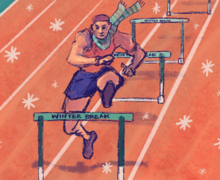Garrett Shrader’s passing struggles continue in blowout loss to No. 25 NC State
Courtesy of Emily Hall
Garrett Shrader threw for less than 70 yards passing for the third consecutive game.
Get the latest Syracuse news delivered right to your inbox.
Subscribe to our sports newsletter here.
For the third game in a row, Garrett Shrader threw for less than 70 passing yards. It’s the first time since 2013 that a Syracuse quarterback has tossed for under 100 passing yards in three consecutive games (minimum 10 passing attempts).
Against Boston College, it didn’t hurt the Orange, who pulled out a 21-6 win courtesy of Shrader and Sean Tucker’s rushing abilities and a punt return touchdown. But in the two games that followed against Louisville and most recently against NC State, it did cost the Orange. Shrader’s passing struggles cost them big-time as his team slipped up in both opportunities to get to six wins and become bowl eligible.
Shrader threw a pick six in Raleigh, North Carolina, and finished 8-of-20 passing, a stat that was further padded by five third-quarter completions that came in garbage time. The SU quarterback didn’t complete a pass for two entire quarters of football, tossing seven straight incompletions as his statline slipped from 3-of-6 to 3-of-13.
But the loss doesn’t all fall on Shrader. In Saturday’s 24-point loss to NC State (8-3 , 5-3 Atlantic Coast), the defense gave up two touchdowns, and the special teams unit allowed a 97-yard kickoff return in a matter of six minutes. But for Shrader, he’ll get one final chance against a ranked Pittsburgh team to lead the Orange (5-6, 2-5 ACC) to bowl eligibility.
“The quarterback has the keys to the car, and if you don’t have a quarterback, you can’t really do much,” Shrader said on Nov. 10. “If things are going well, I probably have a little something to do with it, and if things aren’t going well, I probably have a little something to do with that too.”
Things were going well for Shrader when he first took over the Syracuse starting job though. He was never an elite slinger of the ball, but instant success with his legs made up for missed throws. His first start against Liberty featured 77 yards passing and a 40% completion percentage, though he rushed for two scores. FSU was an improvement with 150 passing yards and three rushing touchdowns, and the Syracuse passing game picked up steam for the next three straight games, despite close losses.
Back then, there were more “give me” passes with fewer defenders in the box, Syracuse head coach Dino Babers said after the NC State game when asked what’s changed with Shrader recently. Then against Boston College, Shrader started struggling again. He threw 3-of-13 in the first half, prompting Babers and the offense to throw the ball just once in the second half.
Louisville was a disastrous offensive outing, including the passing game, and NC State was more of the same. Opposing defenses from the past three games have used varying schemes, Shrader said, which changes which windows he tries to hit. But the bottom line is simple: “All those little things don’t really matter if I don’t hit open guys,” he said.
“It is what it is,” Shrader said after the 41-17 defeat. “(I’m) frustrated because I didn’t help us win, or even compete, today.”
In Syracuse’s opening series, the SU quarterback tried to scramble but couldn’t succeed. He threw low to Damien Alford for an incompletion and took a third-down sack. The Orange punted.
Shrader was aided by a plethora of penalties, including two late hits on third downs, but the offense still wasn’t clicking under his command. Babers was adamant about throwing the ball a lot early since the Wolfpack were focused on loading the box and stopping the run, the Orange head coach said after the game. Shrader said they felt good about it, and they had good looks. He just couldn’t deliver.
“You hit those shots in the throwing game, you open it up right away, and that’s the key,” Babers said when asked about SU’s continuous problem of starting slowly. He repeated iterations of that same sentiment — regarding missed throwing lanes — multiple times during his postgame press conference.
The Mississippi State transfer threw toward a covered Alford on SU’s second series, threw to Tucker on a predictable outlet pass and tried to scramble on third-and-16 but couldn’t. The second quarter was more of the same. Shrader was under pressure frequently, and when he stepped up and tried to unleash a pass toward Sharod Johnson, who was running a crossing route, he missed the throw and SU had to punt.
“If you checked, we were throwing the ball and there were guys wide-open,” Babers said. “We hit those guys instead, we change the game dramatically, and we get a more balanced attack.”
After a solid kickoff runback from Cooper Lutz, the progress was undone, and then some, when Shrader let go of an underthrown ball. Linebacker Drake Thomas was in the lane, and he snagged the poor pass and slipped by Shrader for the touchdown. After the game, he said he wished he’d thrown it away or taken the sack.
As the game progressed, Shrader continued to miss receivers both high and low. In the third quarter when SU was down three scores and needed to gather momentum out of halftime, Shrader was hurried by pressure. He rolled to his right and threw on the run toward a wide-open Devaughn Cooper. But Shrader’s throw was yards short, and he missed the next one toward Johnson on the following third-and-11.
“It’s my responsibility to make plays and get the ball to those guys,” Shrader said, emphasizing that Cooper did well to get open. “(I) got to make those plays.”
Babers said passing-game issues are multi-faceted, and include things like timing, whether receivers are getting open and running the right routes and the delivery of throws. “There’s a lot of stuff going on,” he said.
Shrader did eventually get going in Raleigh. He threw five straight completions in the third quarter when the game was all but decided and scrambled for a 48-yard run in the fourth. But for SU, at least this time around, it came too late.
Published on November 20, 2021 at 10:03 pm
Contact Roshan: rferna04@syr.edu | @Roshan_f16






